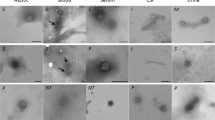Abstract
The isolation of bacteriophages targeting most clinically relevant bacteria is reasonably straightforward as long as its targeted host does not have complex chemical, physical, and environmental requirements. Often, sewage, soil, feces, and different body fluids are used for bacteriophage isolation procedures, and following enrichment, it is common to obtain more than a single phage in a sample. This chapter describes a simple method for the enrichment and isolation of bacteriophages from liquid and solid samples that can be adapted for different clinically important aerobic bacteria.
Access this chapter
Tax calculation will be finalised at checkout
Purchases are for personal use only
Similar content being viewed by others
References
Hansen GT (2021) Continuous evolution: perspective on the epidemiology of carbapenemase resistance among Enterobacterales and other gram-negative bacteria. Infect Dis Ther 10:75–92. https://doi.org/10.1007/s40121-020-00395-2
Dalton KR, Rock C, Carroll KC, Davis MF (2020) One health in hospitals: how understanding the dynamics of people, animals, and the hospital built-environment can be used to better inform interventions for antimicrobial-resistant gram-positive infections. Antimicrob Resist Infect Control 9:78. https://doi.org/10.1186/s13756-020-00737-2
LaBauve AE, Wargo MJ (2012) Growth and laboratory maintenance of Pseudomonas aeruginosa. Curr Protoc Microbiol 25: 6E.1.1–6E.1.8. https://doi.org/10.1002/9780471729259.mc06e01s25
Benoit T, Cloutier M, Schop R et al (2020) Comparative assessment of growth media and incubation conditions for enhanced recovery and isolation of Acinetobacter baumannii from aquatic matrices. J Microbiol Methods 178:106023. https://doi.org/10.1016/j.mimet.2020.106023
Missiakas DM, Schneewind O (2013) Growth and laboratory maintenance of Staphylococcus aureus. In: Current protocols in microbiology, p Unit9C.1
Blair JMA, Webber MA, Baylay AJ et al (2015) Molecular mechanisms of antibiotic resistance. Nat Rev Microbiol 13:42–51. https://doi.org/10.1038/nrmicro3380
Mancuso G, Midiri A, Gerace E, Biondo C (2021) Bacterial antibiotic resistance: the most critical pathogens. Pathogens 10:1310. https://doi.org/10.3390/pathogens10101310
De Angelis G, Fiori B, Menchinelli G et al (2018) Incidence and antimicrobial resistance trends in bloodstream infections caused by ESKAPE and Escherichia coli at a large teaching hospital in Rome, a 9-year analysis (2007–2015). Eur J Clin Microbiol Infect Dis 37:1627–1636. https://doi.org/10.1007/s10096-018-3292-9
Dion MB, Oechslin F, Moineau S (2020) Phage diversity, genomics and phylogeny. Nat Rev Microbiol 18:125–138. https://doi.org/10.1038/s41579-019-0311-5
Philipson CW, Voegtly LJ, Lueder MR et al (2018) Characterizing phage genomes for therapeutic applications. Viruses 10:188. https://doi.org/10.3390/v10040188
D’Hérelle F (1926) Le bactériophage et son comportement. Masson, Paris
Hyman P (2019) Phages for phage therapy: isolation, characterization, and host range breadth. Pharmaceuticals 12:35. https://doi.org/10.3390/ph12010035
Myers J, Davis J II, Lollo M et al (2023) More’s the same – multiple hosts do not select for broader host range phages. Viruses 15:518. https://doi.org/10.3390/v15020518
Sillankorva S, Pleteneva E, Shaburova O et al (2010) Salmonella Enteritidis bacteriophage candidates for phage therapy of poultry. J Appl Microbiol 108:1175–1186. https://doi.org/10.1111/j.1365-2672.2009.04549.x
Lazarus AS, Gunnison JB (1947) The action of Pasteurella pestis bacteriophage on Pasteurella, salmonella, and Shigella. J Bacteriol 54:70
Green J, Goldberg RB (1985) Isolation and preliminary characterization of lytic and lysogenic phages with wide host range within the streptomycetes. J Gen Microbiol 131:2459–2465. https://doi.org/10.1099/00221287-131-9-2459
Pinto AM, Faustino A, Pastrana LM et al (2021) Pseudomonas aeruginosa PAO 1 in vitro time-kill kinetics using single phages and phage formulations – modulating death, adaptation, and resistance. Antibiotics 10:877. https://doi.org/10.3390/antibiotics10070877
Serwer P, Hayes SJ, Zaman S et al (2004) Improved isolation of undersampled bacteriophages: finding of distant terminase genes. Virology 329:412–424. https://doi.org/10.1016/j.virol.2004.08.021
Santos SB, Carvalho CM, Sillankorva S et al (2009) The use of antibiotics to improve phage detection and enumeration by the double-layer agar technique. BMC Microbiol 9:148. https://doi.org/10.1186/1471-2180-9-148
Ackermann HW, Audurier A, Berthiaume L et al (1978) Guidelines for bacteriophage characterization. Adv Virus Res 23:1–24. https://doi.org/10.1016/S0065-3527(08)60096-2
Ackermann HW (1998) Tailed bacteriophages: the order Caudovirales. Adv Virus Res 51:135–201. https://doi.org/10.1016/s0065-3527(08)60785-x
Acknowledgments
SS acknowledges funding from the Portuguese Foundation for Science and Technology (FCT) through the individual scientific employment program contract (2020.03171.CEECIND).
Author information
Authors and Affiliations
Corresponding author
Editor information
Editors and Affiliations
Rights and permissions
Copyright information
© 2024 The Author(s), under exclusive license to Springer Science+Business Media, LLC, part of Springer Nature
About this protocol
Cite this protocol
Sillankorva, S., Hyman, P. (2024). Isolation of Bacteriophages for Clinically Relevant Bacteria. In: Azeredo, J., Sillankorva, S. (eds) Bacteriophage Therapy. Methods in Molecular Biology, vol 2734. Humana, New York, NY. https://doi.org/10.1007/978-1-0716-3523-0_1
Download citation
DOI: https://doi.org/10.1007/978-1-0716-3523-0_1
Published:
Publisher Name: Humana, New York, NY
Print ISBN: 978-1-0716-3522-3
Online ISBN: 978-1-0716-3523-0
eBook Packages: Springer Protocols




